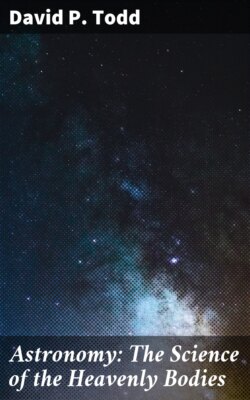Читать книгу Astronomy: The Science of the Heavenly Bodies - David P. Todd - Страница 17
На сайте Литреса книга снята с продажи.
CHAPTER XIII
NEWTON AND MOTION
ОглавлениеTable of Contents
"How is it that you are able to make these great discoveries?" was once asked of Sir Isaac Newton, facile princeps of all philosophers, and the discoverer of the great law of universal gravitation.
"By perpetually thinking about them," was Newton's terse and illuminating reply. He had set for himself the definite problem of Kepler's laws: why is it that they are true, and is there not some single, general law that will embody all the circumstances of the planetary motions?
Newton was born in 1643, the year after the death of Galileo. He had a thorough training in the mathematics of his day, and addressed himself first to an investigation and definite formulation of the general laws of motion, which he found to be three in number, and which he was able to put in very simple terms. The first one is: Any body, once it is set in motion, will continue to move forward in a straight line with a uniform velocity forever, provided it is acted upon by no force whatever. In other words, a state of motion is as natural as a state of rest (rest in relation to things everywhere adjacent) in which we find all things in general.
Here on earth where gravity itself pulls all objects downward toward the earth, and where resistance of the air tends to hold a moving body back and bring it to rest, and where friction from contact with whatever material substance may be in its path is perpetually tending to neutralize all motion—with all three of these forces always at work to stop a moving body, the truth of this first and fundamental law of motion was not apparent on the surface.
Till Galileo's time everyone had made the mistake of supposing that some force or other must be acting continually on every moving body to keep it in motion. Ptolemy, Copernicus, Kepler, Leonardo da Vinci—all failed to see the truth of this law which Newton developed in the immortal Principia. And at the present day it is not always easy to accept at first, although the progress of mechanical science, by reducing friction and resistance, has produced machines in which motion of large masses may be kept up indefinitely with the application of only the merest minimum of force.
Once a planet is set in motion round the sun, it would go on forever through frictionless, non-resistant space; but there must be a central force, as Huygens saw clearly, to hold it in its orbit. Otherwise it would at any moment take the direction of a tangent to the orbit. Here is where Newton's second law of motion comes in, and he formulated it with great definiteness. When any force acts on a moving body, its deviation from a straight line will be in the direction of the force applied and proportional to that force.
In accord with this law, Newton first began to inquire whether the force of attraction here on earth, which everyone commonly recognizes as gravity, drawing all things down toward the center of the earth, might not extend upward indefinitely. It is found in operation on the summits of mountain peaks, and the clouds above them and the rain falling from them are obviously drawn downward by the same force. May it not extend outward into space, even as far as the moon?
This was an audacious question, but Newton not only asked, but tried to answer it in the year 1665, when he was only twenty-three. On the surface of the earth this attraction is strong enough to draw a falling body downward through a vertical space of sixteen feet in a second of time. What ought it to be at the distance of the moon. The distance of the moon in Newton's time was better known in terms of the earth's size than was the size of the earth itself: the earth's radius was known to be one-sixtieth of the moon's distance, but the earth's diameter was thought to be something under 7,000 miles, so that Newton's first calculations were most disappointing, and he laid them aside for nearly twenty years.
Meanwhile the French astronomers led by Picard had measured the earth anew, and showed it to be nearly 8,000 miles in diameter. As soon as Newton learned of this, he revised his calculations, and found that by the law of the inverse square the moon, in one second, should fall away from a tangent to its orbit one thirty-six hundredth of sixteen feet.
This accorded exactly with his original supposition that the earth's attraction extended to the moon. So he concluded that the force which makes a stone fall, or an apple, as the story goes, is the same force that holds the moon in its orbit, and that this force diminishes in the exact proportion that the square of the distance from the earth's center increases. The moon, indeed, becomes a falling body; only, as Kingdon Clifford puts it: "She is going so fast and is so far off that she falls quite around to the other side of the earth, instead of hitting it; and so goes on forever."
